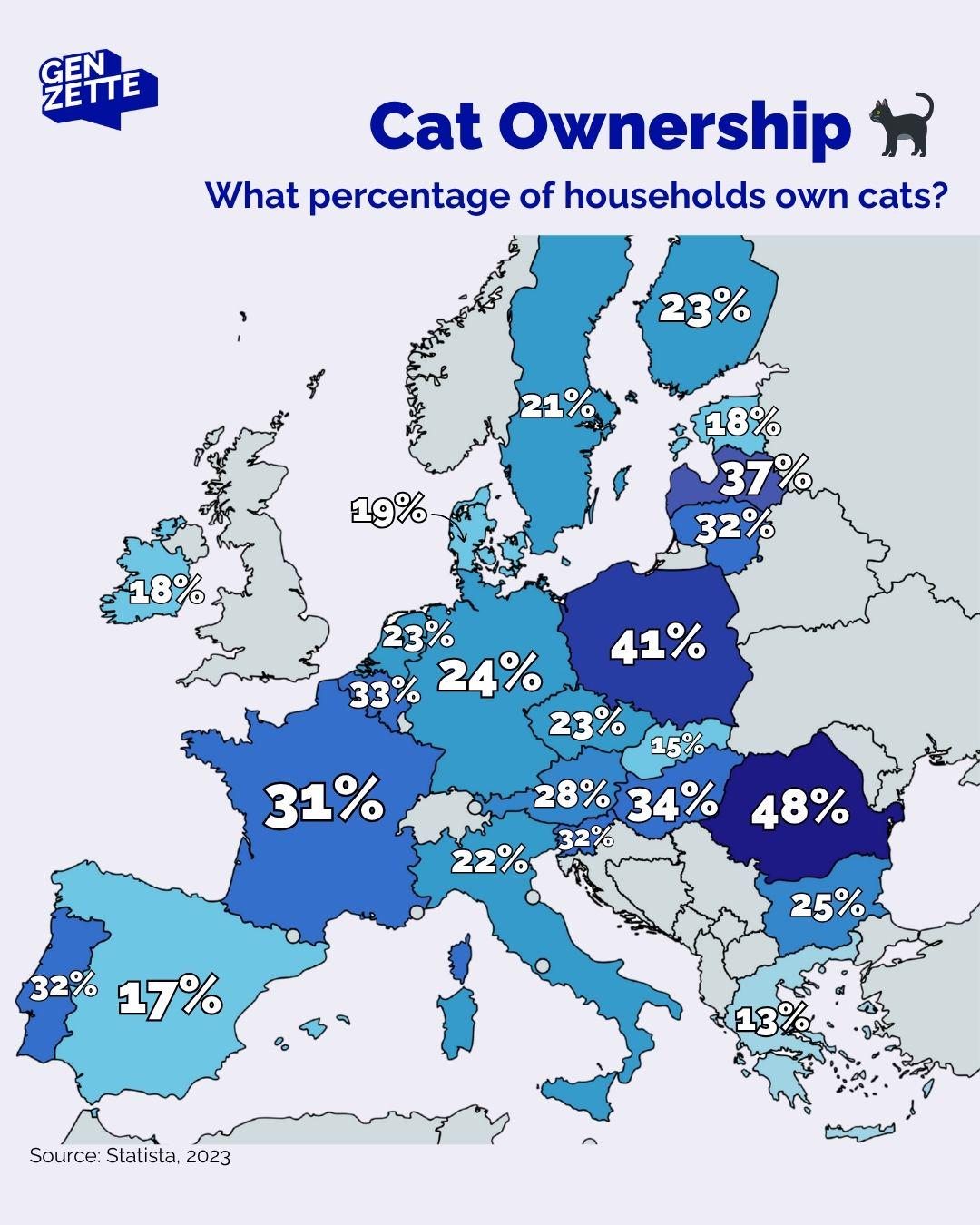Cat Ownership in the EU by Member State Map


Marcus Rodriguez
Historical Geography Expert
Marcus Rodriguez specializes in historical cartography and geographic data analysis. With a background in both history and geography, he brings unique...
Geographic Analysis
What This Map Shows
The "Cat Ownership in the EU by Member State" map provides a vivid representation of cat ownership rates across the European Union. This visualization highlights the percentage of households in each member state that own at least one cat, giving us insight into the cultural attitudes towards pets in various countries. As we explore this topic, let's delve into the fascinating world of pet ownership in Europe and understand what these figures reveal about our feline friends and their humans.
Deep Dive into Cat Ownership in the EU
Cats have long been cherished companions, often seen as symbols of independence and mystery. In Europe, cat ownership reflects diverse cultural attitudes, lifestyles, and even urban versus rural living preferences. According to recent statistics, approximately 25% of households in the EU have a cat, which translates to around 100 million pet cats living across the continent. What's particularly interesting is the variation in ownership rates from one country to another.
For instance, countries like France, Germany, and Italy lead the pack, boasting cat ownership rates of 30% or more. France, in particular, is known for its strong affinity for cats; it has one of the highest rates of cat ownership in Europe, with more than 13 million pet cats. This love for felines can be attributed to the cultural significance of cats in French households, where they are often viewed as family members rather than just pets.
On the other hand, Eastern European countries tend to show lower rates of cat ownership. In places like Bulgaria or Romania, the percentage of households with cats hovers around 10-15%. Factors influencing these differences include economic conditions, urbanization, and cultural attitudes towards animals. In many Eastern European nations, dogs are more commonly kept as pets, often serving as guard animals or companions, while cats might be more associated with rural life.
Interestingly, the demographics of pet ownership extend beyond mere numbers. In countries with higher cat ownership rates, you often find a corresponding trend of smaller living spaces, particularly in urban environments where people seek companionship without the need for extensive outdoor space. Cats, being more independent than dogs, fit well into the busy lives of city dwellers, requiring less direct attention and offering a sense of comfort and companionship.
Regional Analysis
Looking at the map, we can categorize EU member states into three broad regions based on cat ownership rates: high, medium, and low ownership countries.
1. **High Ownership Countries**: As mentioned, France and Germany are leaders in cat ownership. Other countries in this category include Italy and the Netherlands, where the affection for cats is reflected in various cultural expressions, from literature to art. Interestingly, in these nations, there is also a robust market for pet-related products, indicating a flourishing pet industry.
2. **Medium Ownership Countries**: Countries like Spain, Belgium, and Sweden show moderate cat ownership rates between 20-30%. In these regions, societal attitudes towards pets are evolving, with more people recognizing the emotional and psychological benefits of having cats. Campaigns promoting animal adoption have also contributed to these numbers rising in recent years.
3. **Low Ownership Countries**: Many Eastern European countries, including Poland and Hungary, find themselves in the lower range of cat ownership. Cultural factors play a significant role here; for example, in some rural areas, cats might be viewed predominantly as working animals, controlling pests rather than companions. However, as urbanization increases, there might be a gradual shift toward greater acceptance of cats as household pets.
Significance and Impact
Understanding cat ownership in the EU is not just about numbers; it reflects deeper social dynamics and changing lifestyles. The rise in cat ownership is linked to a broader trend of pet humanization, where pets are increasingly seen as family members. This shift has implications for various industries, including pet food, veterinary care, and even housing, as more landlords and developers cater to pet owners.
Moreover, the impact of pet ownership extends to mental health. Studies have shown that having a cat can reduce stress and loneliness, which has become especially relevant in the wake of the COVID-19 pandemic. Many people turned to pets for companionship during lockdowns, and the long-term effects of this trend may lead to increased pet ownership rates across Europe.
As we look to the future, it will be intriguing to see how cat ownership evolves in the EU. Will we see a rise in adoption rates as awareness of the benefits of pet ownership grows? Or will economic factors lead to a decline in ownership? Only time will tell, but for now, the map serves as a snapshot of our current relationship with our feline friends across Europe.
In conclusion, the "Cat Ownership in the EU by Member State Map" is more than just a visualization; it encapsulates the various attitudes and lifestyles that define how people interact with their pets today, reflecting broader societal changes and trends in the region.
Visualization Details
- Published
- August 15, 2025
- Views
- 148
Comments
Loading comments...